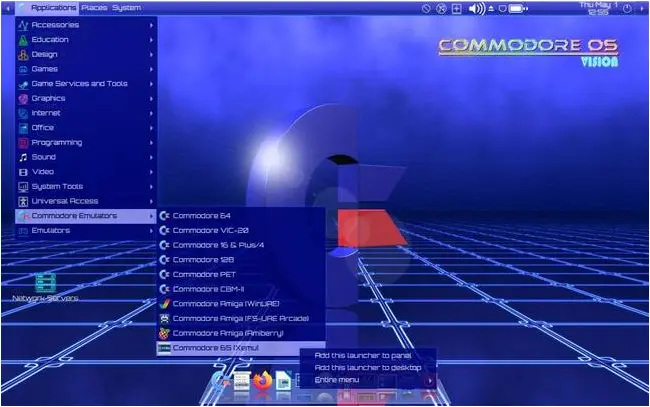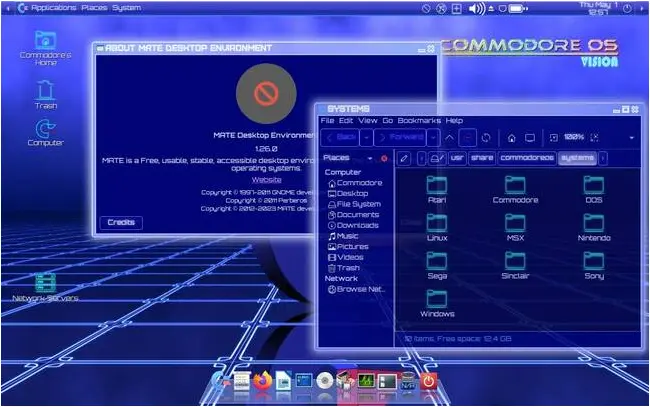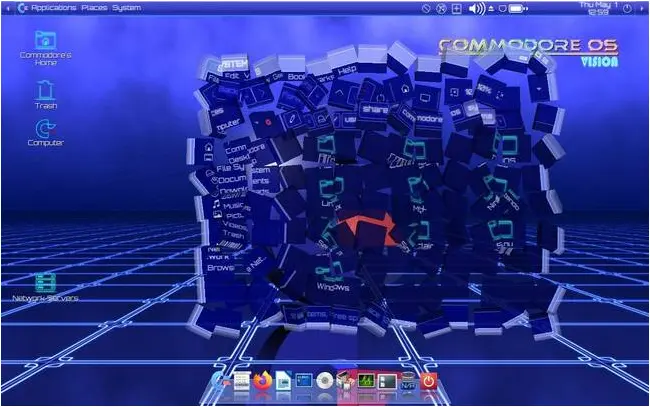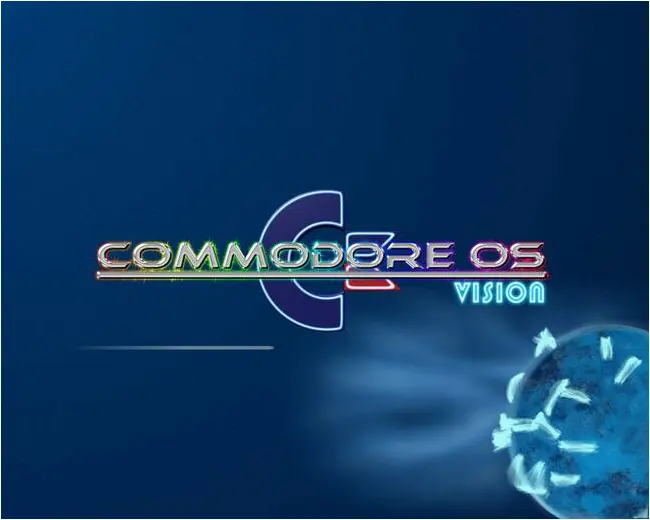Commodore Os 3 Is The Loudest Linux Yet
A Commodore-themed talking Linux desktop, complete with hundreds of games, makes for the biggest distro we’ve seen yet.
In the halcyon days of 2011, The Register reported on a plan to make a modern PC clone in the classic form factor of the Commodore 64 after CEO Barry Altman had some troubles licensing the Commodore name (eventually resolved). The product did in fact launch, although sadly Altman died the following year. Now MyRetroComputer owns the rights and the design, and you can still buy the case.

Commodore OS 3 comes with a selection of CBM emulators, but you’ll need Amiga ROMs – click to enlarge
What is more interesting to The Reg FOSS desk, though, is that this machine has its own OS – a Linux distribution called Commodore OS. Developer Leo Nigro of Commodore USA just released version 3.0. Internally, it describes itself as COMMODORE OS VISION 3.0 (Beta 8).
Commodore OS 3 is based on MX Linux 23.4, but it’s been extensively customized. In fact, in some 30 years of experimenting with Linux, this vulture can say he has never seen a distro this tricked out with visual and sound effects. We suggest closely reading the installation instructions and following them. It’s also seriously big: the ISO file is 37.85 GB in size. Part of this is because of the 204 Linux games that are preinstalled, but there is also a large assortment of emulators, covering ten models of Commodore kit from the PET via the C16, C64, and Plus 4, to several models of Amiga, and about 30 other platforms besides.

There are lots of other emulators here too, but beware, many of these folders are empty – click to enlarge
Not all of the emulators work out of the box. Several require proprietary ROMs, which aren’t included. As with several other such emulation projects, including the Slovakian AmiKit, the easiest way to legally obtain ROMs is to buy Cloanto’s Amiga Forever.
As the distro is based on MX Linux, it uses the same installation program – but we weren’t prepared for the system requirements. It wants a minimum of 84 GB of disk space to install. We nuked our 20 GB test VM and created a new one with 100 GB. It makes Zorin OS’s mere 20 GB of Flatpaks look svelte. But don’t think that means it’s a boring installation: there’s an animated 3D wireframe wallpaper and a background tune.
It uses the MATE desktop, tricked out with a custom theme, sound effects, startup music, and the Orca screen reader enabled by default so that your computer talks in a robotic voice. Mousing over the icons in the translucent 3D dock makes them spin, and clicking on one makes it burst into flames before opening. Then, a transparent ghost of the window zooms up to full size. Windows don’t just wobble, when closed they dissolve into spinning blocks. Tooltips spin into and out of view, and of course switching between virtual desktops uses a rotating cube. Although the mouse pointer is somewhat Amiga-style in that it’s red and rakishly angled, it’s also 3D and spins on its axis. The console font is a reproduction of the C64’s screen font, and the default Linux terminal prompt is:
Commodore@Commodore ~READYThat tells you that the machine name is “Commodore,” with a capital C, and so is the default user account. The default password, incidentally, is C=, a nod to CBM’s classic chicken head logo.

One of the few animated effects we could grab was the dissolving of a closed window into spinning cubes – click to enlarge
For us, the slightly disappointing truth is that under all the chrome, the desktop is MATE, with the classic top panel containing Applications, Places, and System menus, plus the Cairo dock at bottom center. We would think that the OS for a recreation Commodore box was a golden opportunity to showcase some Amiga Workbench recreation, or at least AmiWM, but sadly not.
There are some unusual additions alongside the bunch of emulators. For instance, there is a full-screen version of Commodore OS BASIC, plus a graphical IDE. The banner screen says it’s enhanced – but this doesn’t extend to the HELP command, which doesn’t work. One of the pages of the documentation refers to the language as RCBasic, which we suspect may be the origin. There are half a dozen other BASICs and other languages, too.
There are all the usual accoutrements of every Linux desktop here. As in, pretty much anything you can imagine is preinstalled. For instance, there’s Firefox, and Chrome, and Chromium, plus lots of proprietary tools such as Zoom, Slack, Spotify, TeamViewer, and more. There are multiple video programs, including big ones like OBS Studio, and a dozen or so graphics editors like Krita, Inkscape, GIMP 2.10, Blender, and more.

Obviously the loading screen is animated, too: not just a progress bar, but looming clouds, and an accompanying chiptune – click to enlarge
There is a mindset among some Linux distro maintainers that the way to create a killer product is to include every tool that any user might want, so that users don’t need to go and find things for themselves or work out how to install them. The paid version of Zorin OS is at the moderate end of this scale, for instance, and antiX Linux is at the minimalist end: most of its apps are tiny and lightweight, but even so it has 13 desktop options on the login screen.
Our impression is that this is especially prevalent where the Linux and Amiga worlds overlap. We have experimented with PiMiga, which goes to a new extreme in our experience. Creator Chris Edwards manages to combine both x86-64 and Arm64 editions of Debian into a single 37 GB system image, plus lots of Amiga tools, games, demos, and more besides, and the Amiberry Amiga emulator.
The result is that the same OS will boot and run on both an x86-64 PC and on a Raspberry Pi 4 or better. (We would link to it, but as far as we know, it has no homepage or anything, just the creator’s YouTube channel, and you are supposed to download it over BitTorrent, although we found a copy on the Internet Archive. You can read a little about it on Cubicle Nate’s blog.)
PiMiga is technologically very impressive indeed, but we would rather just pick the appropriate version for our hardware. That, however, is not an option. (Oh, and again, you need to bring your own ROMs.)
Commodore OS Vision is somewhere on the same scale. It’s MX Linux with MATE, featuring every imaginable bit of audiovisual bling enabled, all turned up to 11. It also has a vast preinstalled library of software, including dozens of emulators, and for those emulated platforms, a veritable hoard of demos, games, and more.
When we read about PiMiga, we were hoping for an Amiga-like OS for the Raspberry Pi, but it isn’t anything like that. It’s an amazing demo of how much you can squeeze into a single OS image.
We thought Commodore OS Vision might be, well, a vision of a Commodore OS based on Linux – but it’s nothing like that. However, if you want the maximum in special effects and every app you might want preinstalled, saving you from hunting them down, then it’s here for you to enjoy. ®
A considerable amount of time and effort goes into maintaining this website, creating backend automation and creating new features and content for you to make actionable intelligence decisions. Everyone that supports the site helps enable new functionality.
If you like the site, please support us on “Patreon” or “Buy Me A Coffee” using the buttons below
To keep up to date follow us on the below channels.

![Mythic C2 Detected - 188[.]124[.]51[.]141:7443 1 mythic](https://www.redpacketsecurity.com/wp-content/uploads/2025/10/mythic.png)
![[NOVA] - Ransomware Victim: Regency Specialist Hospital 2 image](https://www.redpacketsecurity.com/wp-content/uploads/2024/09/image-300x300.png)

